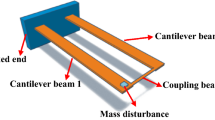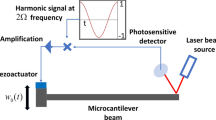Abstract
The eigenmode shift in weakly coupled resonators is used for ultra-sensitive micro-mass measurements. For operation in viscous environments, positive velocity feedback is often applied to compensate for the damping effect on the resonators. In the feedback, the real-time sensing of the displacement or velocity of the resonators is essential and in downsizing, a relatively large noise produced in a specific sensor for the velocity or displacement of the resonator may degrade the detection of the mode shift. In this study, we propose using parametric resonance to detect the mode shift without feedback control. Applying the harmonic balance method to an analytical model of coupled cantilevers, we clarify the unstable parameter region in which the resonators are parametrically excited with the first or second eigenmode. We also experimentally confirm without a special environment such as high vacuum, i.e., in air, that the parametrically excited coupled cantilevers produce a highly sensitive mode shift depending on the added mass. The sensitivity of the proposed method is increased by a factor of about \({{10}^{3}}\) in the first mode and \({{10}^{2}}\) in the second mode compared with the sensitivity in the conventional method based on the natural frequency shift of a single resonator.





Similar content being viewed by others
Data availability
The datasets of the current study are available from the corresponding author on reasonable request.
References
Zhang, H., Marma, M.S., Bahl, S.K., Kim, E.S., McKenna, C.E.: Sequence specific label-free DNA sensing using film-bulk-acoustic-resonators. IEEE Sens. J. 7(12), 1587 (2007)
Lee, S., Cho, J., Lee, Y., Jeon, S., Cha, H.J., Moon, W.: Measurement of hepatitis B surface antigen concentrations using a piezoelectric microcantilever as a mass sensor. J. Sens. (2012). https://doi.org/10.1155/2012/217958
Ilic, B., Yang, Y., Craighead, H.G.: Virus detection using nanoelectromechanical devices. Appl. Phys. Lett. 85(13), 2604 (2004)
Hajjam, A., Pandiyan, J., Rahafrooz, A., Pourkamali, S.: MEMS resonant sensors for detection of gasoline vapor. In: SENSORS, 2010 IEEE (IEEE, 2010), pp. 1538–1541
Nomani, M.W., Kersey, D., James, J., Diwan, D., Vogt, T., Webb, R.A., Koley, G.: Highly sensitive and multidimensional detection of NO2 using In2O3 thin films. Sens. Actuators B Chem. 160(1), 251 (2011)
Chen, G.Y., Thundat, T., Wachter, E., Warmack, R.: Adsorption-induced surface stress and its effects on resonance frequency of microcantilevers. J. Appl. Phys. 77(8), 3618 (1995)
Narducci, M., Figueras, E., Lopez, M.J., Gracia, I., Santander, J., Ivanov, P., Fonseca, L., Cané, C.: Sensitivity improvement of a microcantilever based mass sensor. Microelectron. Eng. 86(4–6), 1187 (2009)
Karimpour, M., Ghaderi, R., Raeiszadeh, F.: Vibration response of piezoelectric microcantilever as ultrasmall mass sensor in liquid environment. Micron 101, 213 (2017)
Lee, Y., Lim, G., Moon, W.: A self-excited micro cantilever biosensor actuated by PZT using the mass micro balancing technique. Sens. Actuators A Phys. 130, 105 (2006)
Mouro, J., Tiribilli, B., Paoletti, P.: A versatile mass-sensing platform with tunable nonlinear self-excited microcantilevers. IEEE Trans. Nanotechnol. 17(4), 751 (2018)
Spletzer, M., Raman, A., Wu, A.Q., Xu, X., Reifenberger, R.: Ultrasensitive mass sensing using mode localization in coupled microcantilevers. Appl. Phys. Lett. 88(25), 254102 (2006)
Wang, D.F., Li, X., Yang, X., Ikehara, T., Maeda, R.: Enhancing amplitude changes by mode localization in trio cantilevers with mass perturbation. J. Micromech. Microeng. 25(9), 095017 (2015)
Thiruvenkatanathan, P., Yan, J., Woodhouse, J., Aziz, A., Seshia, A.: Ultrasensitive mode-localized mass sensor with electrically tunable parametric sensitivity. Appl. Phys. Lett. 96(8), 081913 (2010)
Wood, G.S., Zhao, C., Pu, S.H., Boden, S.A., Sari, I., Kraft, M.: Mass sensor utilising the mode-localisation effect in an electrostatically-coupled MEMS resonator pair fabricated using an SOI process. Microelectron. Eng. 159, 169 (2016)
Lyu, M., Zhao, J., Kacem, N., Liu, P., Tang, B., Xiong, Z., Wang, H., Huang, Y.: Exploiting nonlinearity to enhance the sensitivity of mode-localized mass sensor based on electrostatically coupled MEMS resonators. Int. J. Non-Linear Mech. 121, 103455 (2020)
Wang, Y., Zhao, C., Wang, C., Cerica, D., Baijot, M., Xiao, Q., Stoukatch, S., Kraft, M.: A mass sensor based on 3-DOF mode localized coupled resonator under atmospheric pressure. Sens. Actuators A Phys. 279, 254 (2018)
Rabenimanana, T., Walter, V., Kacem, N., Le Moal, P., Bourbon, G., Lardiès, J.: Functionalization of electrostatic nonlinearities to overcome mode aliasing limitations in the sensitivity of mass microsensors based on energy localization. Appl. Phys. Lett. 117(3), 033502 (2020)
Yabuno, H., Seo, Y., Kuroda, M.: Self-excited coupled cantilevers for mass sensing in viscous measurement environments. Appl. Phys. Lett. 103(6), 063104 (2013)
Endo, D., Yabuno, H., Higashino, K., Yamamoto, Y., Matsumoto, S.: Self-excited coupled-microcantilevers for mass sensing. Appl. Phys. Lett. 106(22), 223105 (2015)
Endo, D., Yabuno, H., Yamamoto, Y., Matsumoto, S.: Mass sensing in a liquid environment using nonlinear self-excited coupled-microcantilevers. J. Microelectromech. Syst. 27(5), 774 (2018)
Fairbairn, M., Moheimani, S.: Resonant control of an atomic force microscope micro-cantilever for active Q control. Rev. Sci. Instrum. 83(8), 083708 (2012)
Alhazza, K.A., Daqaq, M.F., Nayfeh, A.H., Inman, D.J.: Non-linear vibrations of parametrically excited cantilever beams subjected to non-linear delayed-feedback control. Int. J. Non-Linear Mech. 43(8), 801 (2008)
Mouro, J., Tiribilli, B., Paoletti, P.: Nonlinear behaviour of self-excited microcantilevers in viscous fluids. J. Micromech. Microeng. 27(9), 095008 (2017)
Lübbe, J., Temmen, M., Rode, S., Rahe, P., Kühnle, A., Reichling, M.: Thermal noise limit for ultra-high vacuum noncontact atomic force microscopy. Beilstein J. Nanotechnol. 4(1), 32 (2013)
Zhang, W., Turner, K.L.: A mass sensor based on parametric resonance. In: Proceedings of the workshop on solid-state sensors and actuators, pp. 49–52 (2004)
Yie, Z., Miller, N.J., Shaw, S.W., Turner, K.L.: Parametric amplification in a resonant sensing array. J. Micromech. Microeng. 22(3), 035004 (2012)
Zhang, W., Baskaran, R., Turner, K.L.: Effect of cubic nonlinearity on auto-parametrically amplified resonant MEMS mass sensor. Sens. Actuators A Phys. 102(1–2), 139 (2002)
Prakash, G., Raman, A., Rhoads, J., Reifenberger, R.G.: Parametric noise squeezing and parametric resonance of microcantilevers in air and liquid environments. Rev. Sci. Instrum. 83(6), 065109 (2012)
Szemplińska-Stupnicka, W.: The generalized harmonic balance method for determining the combination resonance in the parametric dynamic systems. J. Sound Vib. 58(3), 347 (1978)
Bolotin, V.V.: The Dynamic Stability of Elastic Systems. Holden-Day, San Francisco (1964)
Zhao, C., Wood, G.S., Xie, J., Chang, H., Pu, S.H., Kraft, M.: A force sensor based on three weakly coupled resonators with ultrahigh sensitivity. Sens. Actuators A Phys. 232, 151 (2015)
Ekinci, K., Roukes, M.: Nanoelectromechanical systems. Rev. Sci. Instrum. 76(6), 061101 (2005)
Cleland, A.N., Roukes, M.L.: Noise processes in nanomechanical resonators. J. Appl. Phys. 92(5), 2758 (2002)
Nayfeh, A.H., Mook, D.T.: Nonlinear Oscillations. John Wiley & Sons, New York (1979)
Rhoads, J.F., Shaw, S.W., Turner, K.L., Baskaran, R.: Tunable microelectromechanical filters that exploit parametric resonance. J. Vib. Acoust. 127(5), 423 (2005)
Kasai, Y., Yabuno, H., Yamamoto, Y., Matsumoto, S.: Ultra-sensitive minute mass sensing using a microcantilever virtually coupled with a virtual cantilever. Sensors 20(7), 1823 (2020)
Acknowledgements
The present study was supported in part by a Grant-in-Aid for Scientific Research B (No. 16H02318) from the Japan Society for the Promotion of Science (JSPS). Mark Kurban from Edanz Group (https://www.jp.edanz.com/ac) edited a draft of this manuscript.
Funding
The authors have not disclosed any funding.
Author information
Authors and Affiliations
Corresponding author
Ethics declarations
Conflict of interest
The authors declare no conflicts of interest.
Additional information
Publisher's Note
Springer Nature remains neutral with regard to jurisdictional claims in published maps and institutional affiliations.
Appendices
Appendix
A: The sensitivity depending on the position of added mass
The dependency of the mode shift on the position of added mass is theoretically examined under the external excitation [17]. The closer the mass is to the tip, the higher the sensitivity of mass measurement becomes. This result is experimentally shown also in the case under the parametric resonance as follows. Figure 6 shows the experimental results using the system mentioned in Sect. 3.1. The ordinate and abscissa are normalized by the total length of the beam and the eignmode shift in the case when the mass is added at the tip, respectively.
B: Validity of the three-term harmonic balance
Comparing with the stability boundary numerically obtained by 4th-Runge–Kutta method, we employ the three harmonic functions. For \(\gamma =0.8\), the details are as follows.
Figure 7 shows the stability boundaries where the red, blue and green lines stand for the results by the one-term, two-term, and three-term harmonic balance methods, respectively. The numerically obtained results are shown by the plots; the circle and cross denote the combination of the excitation amplitude and frequency for the stable and unstable trivial steady states, respectively. The stability boundary obtained by the three-term harmonic balance method agrees with that by the numerical simulation. Therefore, we employ the three terms in the harmonic balance method.
C: Experimental identification of the damping coefficient
The non-dimensional damping coefficient \(\gamma \) of Eq. (2) is experimentally identified as follows.
We consider the state where one of the two cantilevers can oscillate and the other one is fixed. The equation governing the bending vibration can be expressed as
where \(\rho \) is the cantilever density, A is the cross-sectional area, c is the damping coefficient, E is the Young’s modulus of the constitutive material, and I is the moment of inertia of the cross section. We introduce the representative length (total length) L and the representative time \(T^{\prime }=L^2 \sqrt{\rho A / E I}/\omega \), where \(\omega \) is the minimum value satisfying the following equation:
Then, Eq. (14) is rewritten as
where \(\gamma =c L^{2} /(2 \omega \sqrt{\rho A E I})\). The dots and primes denote the partial derivative with respect to the nondimensional time \(t^*=t/T\) and ordinate, \(x^*=x/L\), respectively. Substituting \(v=U(t^{*}) \phi {(x^{*})}\) into Eq. (16) yields
The following boundary conditions are imposed on the equation of \(\phi \):
In the case of \(0<\gamma <1\), the solution of Eq. (17) is
Experimental results at the excitation frequencies that are in the neighborhood of twice the natural frequency of the first and second modes. Time histories of the cantilevers without the mass in a the first mode and b the second mode. FFT analyses for the time history of the cantilevers without the mass in c the first mode and d the second mode. The predominant frequency spectrums are at c 6.450 Hz and d 6.460 Hz, respectively. FFT analyses for the time history of the vibrator in e the first mode and f the second mode. The predominant frequency spectrums are e 0.116 mm at 12.90 Hz and f 0.121 mm at 12.92 Hz, respectively.
or in the dimensional form
where \(\Omega =1 / T^{\prime }\). Letting the maximum displacement be \(t_{n}\) and the maximum one after the one period be \(t_{n+1}\), \(\gamma \) is expressed by using the logarithmic decrement as
Since Eq. (17) corresponds to the dimensionless equation of motion of the simple pendulum model in the manuscript, we can obtain \(\gamma \) in Eq. (2) from the experimental free oscillation of the cantilever by using Eq. (24).
D: Experimental results in the case when the excitation amplitude is much lower
We conducted the experiments using the coupled cantilevers whose first and second natural frequencies are 6.450 Hz and 6.460 Hz, respectively. In Fig. 8, we show the experimental results in the case when the excitation amplitude is much lower, i,e., \(a_e=0.12\) mm. Also in this case, the first or second mode is selectively resonated depending on the parametric excitation frequency.
E: Schematic and experimental diagrams of the mode shapes
In the first and second modes, the two cantilevers oscillate in phase and out of phase, respectively. They are schematically described in Fig. 9a and b. Figure 10a and b shows experimentally obtained first and second modes under the parametric excitation, respectively.
Rights and permissions
About this article
Cite this article
Enami, W., Yabuno, H., Yamamoto, Y. et al. Mode shift detection of coupled resonators through parametric resonance and its application to mass sensing. Nonlinear Dyn 110, 117–129 (2022). https://doi.org/10.1007/s11071-022-07637-7
Received:
Accepted:
Published:
Issue Date:
DOI: https://doi.org/10.1007/s11071-022-07637-7









